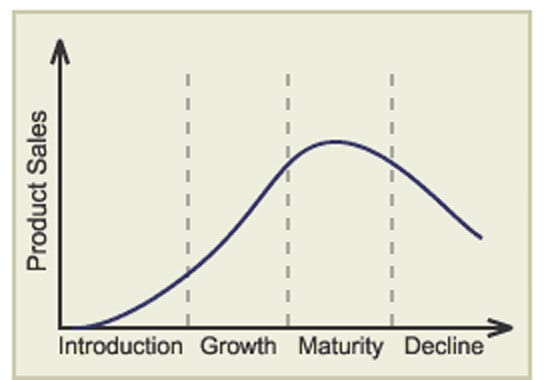Ideas for improving Basket Abandonment Emails that are relevant to other types of email follow-up
On a recent webinar, a question was posed that I thought was worth a second look:
'On an abandonment programme, sending a discount to encourage a purchase may not necessarily be a good idea, so what would be a good hook to get their interest peeked again?'.
This touches on another subject; the inevitable decline in response rates for basket abandonment emails. Some argue against this, but it is inevitable. I consider basket abandonment emails as just another product and therefore they will inevitably follow the same path as any other product, as illustrated in the classic graph below.

So, what can you do to ensure that your results do not decline?
5 Tips to improve email response rates for basket abandonment
- Tip 1 The Basics
Please excuse me for mentioning this, but have you got the basics right? Does your basket abandonment email include the products from the basket? Does the email link straight back to the saved basket? Are you using standard personalisation (e.g. Dear Matthew).Honestly, you’d be surprised how many mailers don’t, or aren’t able, to do this. If you fall into the former, then seriously, get another supplier, you will double conversion rates.
- Tip 2 Optimise
To be fair, this could easily fall into the basics. But whilst getting the basics right is as much to do with set-up as anything else, optimising your basket abandonment emails is post set-up and on-going. An untended basket abandonment email will wilt, mainly because your best customers, intrigued by the first one, will simply get used to receiving them.So what constitutes optimisation of behavioural email? Well, start by testing the usual suspects ( subject line, time sent, copy, creative) to get the best performance. I believe testing is even more valuable with trigger and behavioural email, because the learnings will benefit you for months to come.
- Tip 3 Expand Your Programme
Another very simple way to improve conversion rates is to send one, sometimes 2 follow-ups. Working on the basis that 50% of the recipients won’t open the email, and approximately only 5% will go onto purchase, a cleverly crafted follow-up should achieve 40% of the performance of the initial send
But I emphasis ‘cleverly crafted’… don’t bang out the same email to people who have opened, that is the way to turn relevant email into spam.
- Tip 4 Offers
Or should I say ‘don’t rule out offers’. Firstly, decide what type of customer you want to encourage with an offer. Many online retailers focus on the 2nd sale, aiming to increase the repeat purchase ratio. Perhaps use offers here, and also use business rules on your database to make sure that customers only ever get an offer once.
Alternatively, cross sell with an offer, e.g ‘the item of clothing you left in your basket looks great with these shoes, 20% off’ or ‘people interested in this also looked at this…’. Product recommendations are also useful when seeking to increase engagement with basket abandonment emails. It may be that the abandoner did not find what they were looking for.
- Tip 5 Use Your Customer Data
A final aspect of basket abandonment that will encourage a recipient to read more and click-through is if it is the individual who is being addressed. You should have data on the browser instantly available to you, so USE IT!.For instance, if you can identify this person as a loyal customer or a first time browser then use that information (or indeed any other that is relevant). Greet loyal customers in an appropriate way e.g. ‘Great to see you back again’ or ‘thank you for shopping with us again…’
Once that is all in place, one thing to remind you of is that it is the communication itself that is the primary hook. The email is a reminder, a prompt, or even a disruptive influence on the decision-making process… remember the cliché – don’t ask, don’t get. The simple fact is that if you craft your emails carefully, then performance will improve.
Thanks to Matthew Kelleher for sharing his advice and opinions in this post. Matthew Kelleher is Commercial Director at
Red Eye International. A Masters graduate in Economics from the LSE, Matthew worked for Acxiom for 16 years, starting at NDL, Claritas and most latterly Acxiom. He undertook a variety of divisional director roles, most notably launching Claritas Interactive in 1999 and overseeing its European development. A founder member of the DMA Email Council, Matthew is responsible at RedEye for the service and delivery of email solutions for all clients as well as for the growth of the business. You can follow him on
Twitter or connect on
LinkedIn.







